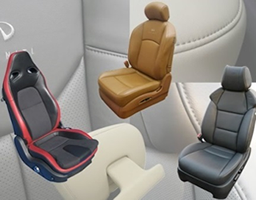Today, the Virtual Prototyping of automotive seating is no longer a vision. Automotive OEMs and seat suppliers, replacing the traditional trial-and-error procedures based on physical prototypes with virtual seat solutions, increasingly use this development process. The result is not only a cost and time-to-market reduction but also an increase in product quality, occupant safety and innovative capability.
Here are some industry leaders already taking full advantage of what Virtual Seat Solution (VSS) has to offer:
- DAS, Dymos, Daewon Sanup, Fuji Seat, Grupo Antolin, Johnson Controls Inc., Lear Corporation, NHK Spring, Sitech, Tachi-S, Toyota Boshoku, TS Tech.
- Bejing Automotive, Chrysler, Suzuki, Geely Automotive, Honda, Hyundai Motor Company, Mazda, Nissan, Renault, Seat, Volkswagen.
Read what some of our customers have to say about their success with VSS.
With Virtual Seat Solution, you benefit from one single environment dedicated solely to the seat – taking into account the automotive seat manufacturing history, virtually seating the occupant, and virtually testing seat performance. You can run accurate and predictive virtual tests in order to certify your physical seat prototype at first try out. Here are more key benefits you can rely on Virtual Seat Solution for:
- Guarantee just-in-time delivery by anticipating manufacturing issues
- Meet regulation requirement: Standard protocols like EuroNCAP, JapanNCAP, ChinaNCAP and IIHS are captured in end-to-end virtual processes, making the virtual certification of each design iteration easier and affordable
- Ensure the right occupant posture by predicting virtually the H-Point as well as inclusion of whiplash and comfort simulation
- Predict the comfort of your innovative seat using a library of human models

At TACHI-S, we have successfully reached greater design targets, fulfilled safety requirements, and improved overall quality in trial phases by adding Virtual Seat Solution into our seat development process. Because there are more than 300 mechanical elements in one seat, designing the seat using virtual seat prototyping at the early stage has greatly shortened the development time.
Mr. Inoue, Manager of CAE Evaluation Section, Test Engineering Department, TACHI-S
ESI Virtual Seat Solution allowed JSP to accurately predict the distortion of parts as they cured. Consequently, we were able to design molds that compensated for that distortion before they were constructed, saving us a tremendous amount of time effort and money. This improvement in JSP’s capabilities is a competitive advantage that we can use to capture additional business and increase our market share
Kipp Boegner, Engineering Manager - JSP